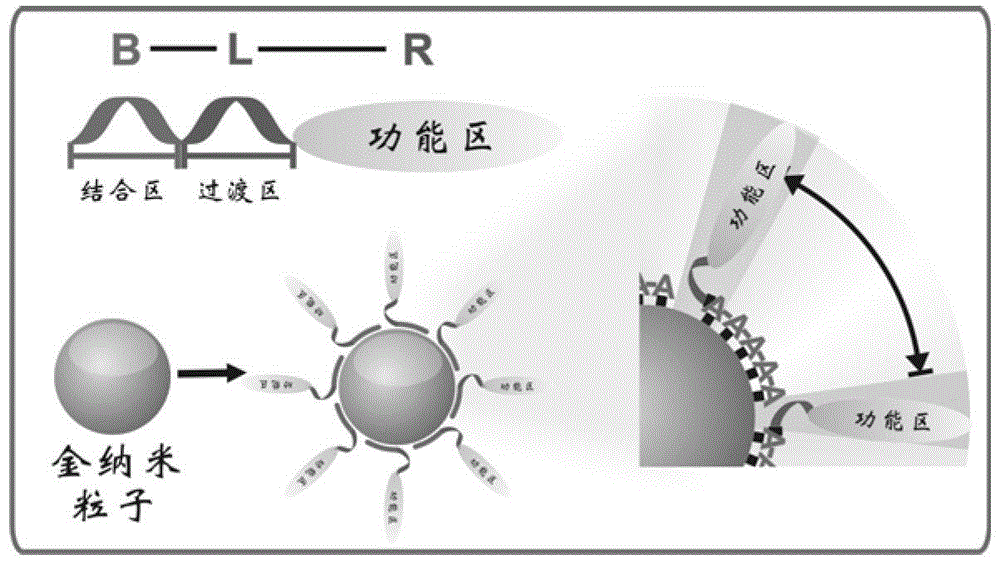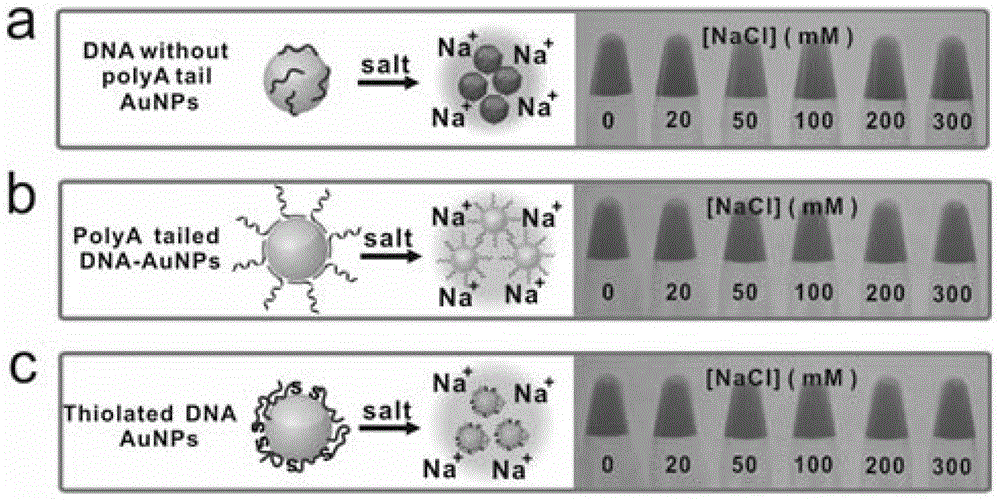A kind of nano-gold composite and its preparation and application
A composite, nano-gold technology, applied in the field of biotechnology and biological detection, can solve the problems of reducing the stability of nano-gold particles, sample contamination, and high cost
- Summary
- Abstract
- Description
- Claims
- Application Information
AI Technical Summary
Problems solved by technology
Method used
Image
Examples
preparation example Construction
[0132] The present invention also provides a preparation method of the nano-gold complex: the functional molecule is contacted with the nano-gold particle, so that the functional molecule is bound to the nano-gold particle through the oligonucleotide binding region rich in adenine nucleotide or its analogue. surface, thereby forming nano-gold complexes.
[0133] In a preferred example of the present invention, steps are included: mixing functional molecules with gold nanoparticles to obtain a mixed solution of functional molecules and gold nanoparticles; The connection of the nucleotide binding region and the surface of the nano-gold particle obtains a solution system containing the nano-gold complex; and the nano-gold complex is separated from the solution. Preferably, it also includes the step of washing and / or verifying the performance of the gold nanocomposite. Those skilled in the art can choose conventional aging agents, such as sodium chloride solution, potassium chlor...
Embodiment 1
[0161] Assembly of the gold nanocomposites
[0162] First, mix the gold nanoparticles and the functional molecules containing the A-rich oligonucleotide binding region in a certain ratio (DNA / nano-gold: 200:1), gently blow to mix, and incubate at room temperature for 16 hours, then add 1MPBS (1M NaCl / 0.1M PB, pH 7.0) to make the final concentration 0.1M PBS (add 5-6 times, 5min / time interval), place at room temperature for 16h, centrifuge at 12000r, 4°C, 20min, and discard Add an equal amount of 0.1M PBS (0.1M NaCl / 10mM PB, pH 7.0) to wash off three times, suspend in the hybridization solution (0.3M NaCl / 10mM PB, pH 7.0), and store in a refrigerator at 4°C for a long time. figure 1 Schematic diagrams of functional molecules and gold nanocomposites are shown.
Embodiment 2
[0164] Stability of DNA-nanogold complexes containing polyA-binding domains in electrolyte solutions
[0165] In order to determine that the oligonucleotide DNA can be stably connected to the surface of gold nanoparticles through the polyA binding region in its structure, this embodiment takes three kinds of DNA samples: (a) no poly adenine nucleotide (polyA) in the DNA (b) binding region A10 composed of polyadenine nucleotides in (b) DNA, (c) sulfhydryl group modified at the end of DNA, the transition region in the above DNA is T5, and the functional regions are all ATgAT gTTCg TTgTg . The above three kinds of DNA were respectively combined with 10nm nano-gold particles to form DNA-nano-gold complexes, and their stability in electrolyte solutions with different ionic strengths was compared.
[0166] Experimental principle: Nanogold with a particle size of 10nm dispersed in the solution is red. After the nanogold is aggregated, the color will be blue-shifted due to the surfac...
PUM
| Property | Measurement | Unit |
|---|---|---|
| particle size | aaaaa | aaaaa |
| particle diameter | aaaaa | aaaaa |
| particle diameter | aaaaa | aaaaa |
Abstract
Description
Claims
Application Information
 Login to View More
Login to View More - R&D
- Intellectual Property
- Life Sciences
- Materials
- Tech Scout
- Unparalleled Data Quality
- Higher Quality Content
- 60% Fewer Hallucinations
Browse by: Latest US Patents, China's latest patents, Technical Efficacy Thesaurus, Application Domain, Technology Topic, Popular Technical Reports.
© 2025 PatSnap. All rights reserved.Legal|Privacy policy|Modern Slavery Act Transparency Statement|Sitemap|About US| Contact US: help@patsnap.com



